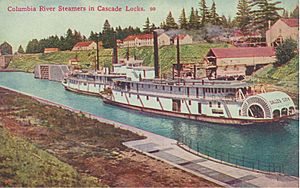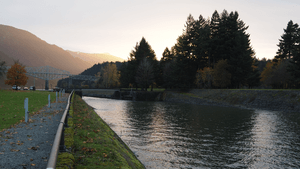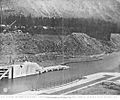Cascade Locks and Canal facts for kids
Quick facts for kids |
|
|
Cascade Locks Marine Park
|
|
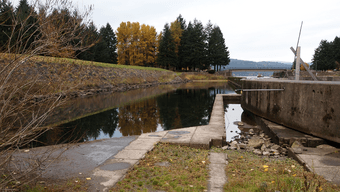
Remnants of the locks as of 2011
|
|
| Lua error in Module:Location_map at line 420: attempt to index field 'wikibase' (a nil value). | |
| Location | On the Columbia River, Cascade Locks, Oregon |
|---|---|
| Area | 64.5 acres (26.1 ha) |
| Built | 1896 |
| NRHP reference No. | 74001686 |
| Added to NRHP | May 15, 1974 |
The Cascade Locks and Canal was an amazing building project on the Columbia River. It was located between the states of Oregon and Washington. Finished in 1896, this project helped steamboats on the Columbia River get past the fast-moving Cascades Rapids. This opened up a clear path for boats from the lower river all the way to The Dalles. The locks were later covered by water and became unused in 1938. This happened when the Bonneville Dam was built, along with new locks, a little way downstream.
Contents
Building the Cascade Locks
As railroads became more popular, steamboats faced tough competition. Shippers and steamboat companies asked the government for money. They wanted to build canals and locks to help steamboats compete better with trains. The two main projects on the Columbia River were the Cascade Locks and, later, the Celilo Canal and Locks.
People started studying how to build a canal at the Cascades in 1875. But interest faded when the Oregon Railroad and Navigation Company (O.R.& N.) finished its railroad to The Dalles. This company then stopped using its boats on the middle river. However, shippers who didn't like monopolies eventually convinced Congress. In 1893, Congress set aside money to start building the canal and locks at the Cascades. These were finished in November 1896.
How the Locks Were Designed
The locks had a special chamber carved into solid rock. This chamber was 460 feet (140 m) long and 90 feet (27 m) wide. It was 8 feet (2.4 m) deep, which was enough for any boat on the river at that time. It was also big enough for several boats at once. The locks could lift a boat 14 feet (4.3 m) when the water was high. They could lift a boat 24 feet (7.3 m) when the water was low.
The lock gates were 56 feet (17 m) wide and 90 feet (27 m) high. The locks were designed very carefully. This was because the river's height changed a lot, sometimes by as much as 55 feet (17 m). To handle this, they built three sets of gates. These gates increased in height from the lower entrance to the huge upper guard gate. Only two sets of gates were used at any one time. When the river was low, the upper guard gates stayed open. The lower sets of gates were used to lift boats. When the water rose high enough to cover the lower gates, they were swung open. Then, the other gates did the lifting work. The upper entrance had a stone wall extending 1,200 feet (370 m). The riverbank behind it was protected from floods with strong rocks.
Impact on River Travel
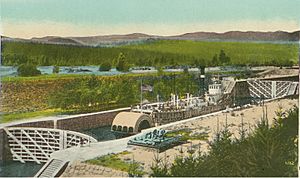
In 1897, soon after the locks were finished, Scientific American magazine was hopeful about their future. They wrote that with cheaper shipping costs, nearby areas would send their goods from here. They also noted that this was just one point on a river that boats could travel for hundreds of miles. They believed the locks would affect all goods shipped in a huge area of about 100,000 square miles (260,000 km2). This was because the locks opened the great Columbia River for trade. They thought that the large amount of wheat grown in Eastern Oregon and Washington would especially benefit from better shipping rates to the coast. From there, it could be sent to Europe.
However, the locks and the 3,000-foot (910 m) canal did not increase river traffic as much as hoped. A new railroad, the North Bank railroad, was also built along the Columbia. This railroad took even more business away from the boats. Because of this, the Regulator Line, which ran steamboats like Dalles City, Regulator, and Bailey Gatzert, sold its business. It was bought by James J. Hill, who owned the Great Northern and other railroads. Later, in 1912, a law called the Panama Canal Act made it illegal for a railroad company to own a competing steamboat line. So, in 1915, Great Northern sold its boats.
What Remains Today

The lower lock and the canal were covered by water when the Bonneville Dam was finished in the 1930s. However, the upper part of the higher lock is still visible today. It is part of Cascade Locks Marine Park in the city of Cascade Locks, Oregon. This park is listed on the National Register of Historic Places, which means it's an important historical site.


